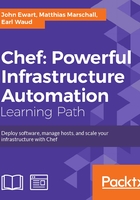
Configuring your local environment
By now, you should have access to a Chef server of some sort; here, we will be using the hosted Chef service, but the work (aside from configuring your knife.rb file) will remain the same across self-managed and hosted Chef instances. In order to follow along with the examples, you will need to configure your workstation with an appropriate knife.rb file and certificates. These files can be downloaded from the hosted Chef console and modified as needed.
Additionally, you will need to have installed knife through the chef gem and have the knife-ec2 gem installed in order to interact with EC2. If you prefer to use a different provider, then you can refer to the previous chapter on how to provision cloud hosts with this provider when you get to the provisioning step.
In our example, using hosted Chef and EC2, our knife.rb file will contain content similar to the following code:
current_dir = File.dirname(__FILE__)
log_level :info
log_location STDOUT
node_name "myorg"
client_key "#{current_dir}/myorg.pem"
validation_client_name "myorg-validator"
validation_key "#{current_dir}/myorg-validator.pem"
chef_server_url "https://api.opscode.com/organizations/myorg"
cache_type 'BasicFile'
cache_options( :path => "#{ENV['HOME']}/.chef/checksums" )
cookbook_path ["#{current_dir}/../cookbooks"]
knife[:aws_access_key_id] = "YOUR AWS ACCESS KEY"
knife[:aws_secret_access_key] = "YOUR AWS SECRET KEY"
knife[:region] = "AWS REGION"
Again, the base files can be downloaded from the hosted Chef console, or if you are using a self-managed Chef installation, this can be found on your Chef server.